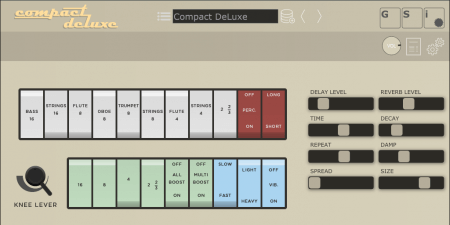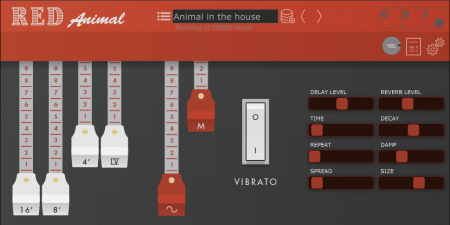Genuine Soundware Compact DeLuxe v1.0.0 WiN
Soft / VST Instruments / VST Effects / VST Plugins
27-07-2023

Among the many transistor organs of the past, also known as "Combo Organs" (mostly because some of them also had a rhythm section and built-in speakers), the Farfisa Compact DeLuxe, along with its big brother the Compact Duo, was one of the most used organs at least in the european beat scene of the early and mid seventies.
The electronic circuit of this kind of organ is relatively simple, at least on paper: rather than using a mechanical tone generator like the tonewheel models (Hammond and Pari), the transistor organs used a circuit called "Top Octave Synthesizer", TOS for short, responsible of the generation of 12 waveforms, one for each note of the last octave of the organ keyboard. The basic waveform was usually something halfway between a ramp and a triangular. The lower octaves were produced by means of "divider" circuits that could halve the frequency of each waveform, going so forth for each lower octave down to the pedalboard tones. At each division, something was lost and something was gained in terms of harmonic content.
he result was that the same notes of different octaves had oscillators perfectly in sync, so all C notes were in sync, all C#, all D and so on. This same technique was also used in so-called "string machines" or "stringer keyboards" that emulated orchestral sounds (violins, trumpets, etc.) - see GSi's Electrorchestra.
The various registers in combo organs were produced by passing the raw waveforms through a filter bank, so some waveforms were low-pass filtered for bass-like sounds, some were high-pass filtered for violin-like sounds, etc. and some waveforms also went through more than one filter. This also adds some level of phase shifting between waveforms coming from different registers, the reason why the sum between, e.g. a Flute 8' and a Violin 8' isn't exactly the superimposition of the two waveforms, but something slightly different. And this is one of those underrated details that made the sound of some Combo Organs pretty unique.
The sound engine of GSi Compact DeLuxe is also included in the GSi Gemini as well as in the Crumar Mojo 61.
Of course this type of instrument gives its best if run through external effects and amps. Have a look at the GSi catalog and experiment with some of the effects offered by GSi.
Main features
Component Modeling engine (no samples, all real-time synthesis)
Full Polyphony (61 notes, 12 Top-Octave Oscillators + Frequency Dividers)
Key multi-contact simulation with authentic and adjustable key click
Authentic recreation of the Farfisa register filters
Recreation of the background noise and leakage
Adjustable vibrato (speed and depth)
Built-in Stereo Delay effect
Built-in Stereo Reverb effect
Built-in programmer with unlimited Programs
Embedded user's manual
Available as Stand-alone application and audio plugin
Very low CPU and RAM usage
A witch says,
While our keygen is true keygen which can work for both WIN/MAC, the binaries included in thisrelease are patched to disble home calling.
home page:
https://goo.su/wtwzvGf
The electronic circuit of this kind of organ is relatively simple, at least on paper: rather than using a mechanical tone generator like the tonewheel models (Hammond and Pari), the transistor organs used a circuit called "Top Octave Synthesizer", TOS for short, responsible of the generation of 12 waveforms, one for each note of the last octave of the organ keyboard. The basic waveform was usually something halfway between a ramp and a triangular. The lower octaves were produced by means of "divider" circuits that could halve the frequency of each waveform, going so forth for each lower octave down to the pedalboard tones. At each division, something was lost and something was gained in terms of harmonic content.
he result was that the same notes of different octaves had oscillators perfectly in sync, so all C notes were in sync, all C#, all D and so on. This same technique was also used in so-called "string machines" or "stringer keyboards" that emulated orchestral sounds (violins, trumpets, etc.) - see GSi's Electrorchestra.
The various registers in combo organs were produced by passing the raw waveforms through a filter bank, so some waveforms were low-pass filtered for bass-like sounds, some were high-pass filtered for violin-like sounds, etc. and some waveforms also went through more than one filter. This also adds some level of phase shifting between waveforms coming from different registers, the reason why the sum between, e.g. a Flute 8' and a Violin 8' isn't exactly the superimposition of the two waveforms, but something slightly different. And this is one of those underrated details that made the sound of some Combo Organs pretty unique.
The sound engine of GSi Compact DeLuxe is also included in the GSi Gemini as well as in the Crumar Mojo 61.
Of course this type of instrument gives its best if run through external effects and amps. Have a look at the GSi catalog and experiment with some of the effects offered by GSi.
Main features
Component Modeling engine (no samples, all real-time synthesis)
Full Polyphony (61 notes, 12 Top-Octave Oscillators + Frequency Dividers)
Key multi-contact simulation with authentic and adjustable key click
Authentic recreation of the Farfisa register filters
Recreation of the background noise and leakage
Adjustable vibrato (speed and depth)
Built-in Stereo Delay effect
Built-in Stereo Reverb effect
Built-in programmer with unlimited Programs
Embedded user's manual
Available as Stand-alone application and audio plugin
Very low CPU and RAM usage
A witch says,
While our keygen is true keygen which can work for both WIN/MAC, the binaries included in thisrelease are patched to disble home calling.
home page:
https://goo.su/wtwzvGf
Related articles
 Genuine Soundware Red Animal v1.0.0 WiN
Genuine Soundware Red Animal v1.0.0 WiN
Soft / VST Instruments / VST Effects / VST Plugins
27-07-2023
Bands like the Doors, the Animals, the Monkees made the Vox Continental one of the most famous electronic organs of the 60's. This particular model was made in the UK and also in Italy and was rather simple in both electronics and features. Like many other electronic organs of the same age, the sound generator is based on the so-called "Top Octave Synthesizer", TOS for short, responsible of the generation of 12 waveforms, one for each note of the last octave of the organ keyboard.
The basic waveform in this case is a low-pass filtered square wave. The lower octaves are produced by means of "divider" circuits that halve the frequency of each waveform, going so forth for each lower octave down to the pedalboard tones. This organ offers only two different registers: Sine and Master, with 4 different foot lengths.
The basic waveform in this case is a low-pass filtered square wave. The lower octaves are produced by means of "divider" circuits that halve the frequency of each waveform, going so forth for each lower octave down to the pedalboard tones. This organ offers only two different registers: Sine and Master, with 4 different foot lengths.
VST Effects / VST Plugins / Audio Soft
29-03-2023
Bands like the Doors, the Animals, the Monkees made the Vox Continental one of the most famous electronic organs of the 60's. This particular model was made in the UK and also in Italy and was rather simple in both electronics and features.
Like many other electronic organs of the same age, the sound generator is based on the so-called "Top Octave Synthesizer", TOS for short, responsible of the generation of 12 waveforms, one for each note of the last octave of the organ keyboard. The basic waveform in this case is a low-pass filtered square wave. The lower octaves are produced by means of "divider" circuits that halve the frequency of each waveform, going so forth for each lower octave down to the pedalboard tones. This organ offers only two different registers: Sine and Master, with 4 different foot lengths.
VST Effects / VST Plugins / Audio Soft
29-03-2023
Among the many transistor organs of the past, also known as "Combo Organs" (mostly because some of them also had a rhythm section and built-in speakers), the Farfisa Compact DeLuxe, along with its big brother the Compact Duo, was one of the most used organs at least in the european beat scene of the early and mid seventies.
The electronic circuit of this kind of organ is relatively simple, at least on paper: rather than using a mechanical tone generator like the tonewheel models (Hammond and Pari), the transistor organs used a circuit called "Top Octave Synthesizer", TOS for short, responsible of the generation of 12 waveforms, one for each note of the last octave of the organ keyboard. The basic waveform was usually something halfway between a ramp and a triangular.
VST Effects / Audio Soft
26-12-2022
Compact organ echoes.
The essence of ’60s go-go and ’80s new wave, nothing sounds quite like the Farfisa combo organ.
The Farfisa hit the pop stage several years before synthesizers. Portable and polyphonic, its reedy voice was heard everywhere.
Thanks to Farfisa V, it never really went away. Our TAE® analog modeling technology recreates every nuance of the Farfisa Compact DeLuxe. How far did we turn up the microscope? To the level of how the vintage circuits passed electrons around, which gets way more realistic than even the best samples. Whether you’re after a retro-cool infusion or something completely different, Farfisa V is an instant inspiration generator.